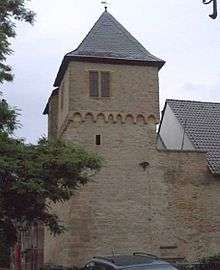Schloss Lauterecken
The Veldenz Schloss of Lauterecken (German: Veldenzschloss Lauterecken) stands in the little Palatine town of Lauterecken and is a cultural monument. It was once the residence of the counts of Palatinate-Veldenz, who lived for four generations that lasted for 151. The schloss is at Veldenzplatz 1. Since 2017 it has been converted and renovated internally in order to become a new 'jewel' for the town of Lauterecken.

History
A Lauterecken Castle was built in the Middle Ages within the Verdun estate of Medard. Gerlach I (1112-1146), a descendant of the counts of Nahe, founded the County of Veldenz (named after the town on the Moselle). The blue Veldenz lion in the coat of arms of Lauterecken still recalls this family. The castle with its characteristic Veldenz tower was first mentioned in 1343. Around 1349, Veldenz received town rights. In 1444, the Wittelsbach count palatine, Stephen of Palatinate-Simmern-Zweibrücken (1385-1459) took over the territory by marriage with Anna (around 1390-1439), the daughter of the last count of Veldenz, and formed the County Palatine of Zweibrücken. Rupert (1506-1544), brother of Count Palatine Louis II of Zweibrücken, took over the guardianship of the underage prince Wolfgang (1526-1569) on Louis's death. Later, out of gratitude, he gave him his own county palatine, which initially consisted of the Ämter (districts) of Veldenz and Lauterecken, the Jettenbach jurisdiction and Remigsberg House (Treaty of Marburg). As founder of the Palatinate-Veldenz line, Rupert Lauterecken raised Lauterecken to the status of a residence town and had a representative schloss built. His son, the "astute" and visionary George Hans (1543-1592), married the Swedish princess Anna Maria from the House of Wasa. He extended the county to include areas of Electoral Palatinate, and later moved his residence to the Alsatian town of Lützelstein (La Petite-Pierre) and founded Pfalzburg. He was followed by his son George Gustavus (1564-1634, cousin of Gustavus Adolphus) and his son Leopold Louis (1625-1694), until the Protestant dynasty of the Palatinate-V Lauterecken finally came into existence in 1733 after many years of disputeKurpfalz. In the later Bavarian period, when Zweibrücken's house was under on the Bavarian throne, the Veldenz lion was absorbed into the Bavarian coat of arms. The bones of 15 members of the House of Palatinate-Veldenz rest in the Provost's Church on the nearby Remigiusberg.
External links
- Information on the schloss (pdf; 1.5 MB)
- Lauterecken